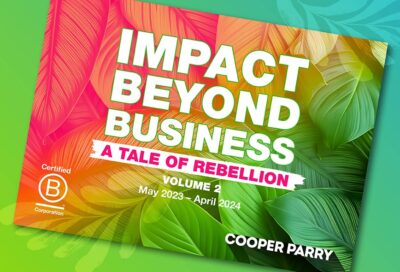Exciting things happen when you bring together a group of likeminded experts. And when sustainability is the collective challenge, the rewards – and the stakes – couldn’t be greater. So, when some of the UK’s brightest ESG minds walked through the doors of our Sky View office for The Balancing Act: Juggling Profit & Purpose, we had a not-so-sneaky suspicion that it would be a morning to remember.
As Nicoleta Voicu, CP’s Head of Sustainability welcomed everyone and MC’ed us through some excellent talks and a fast-paced panel Q&A, the nuggets kept on coming.
Catch up on some of the best bits below.
SUSTAINABLE FINANCING: THE PRESENT. THE FUTURE
Our first guest speaker was Juan David Perez Perez, Impact & Sustainability Manager at Unity Trust Bank, talking us through the bank’s role in making sustainable finance available to purpose-powered organisations.
“As a carbon neutral bank for three years now,” Juan David told us, “Unity believes that finance has an important role to play in achieving a greener future and positively contributing to the UK’s transition to a net zero carbon economy.”
When it comes to climate change and Unity’s customers, they’ve highlighted three key risk areas.
Firstly, the physical risk – understanding the changing physical hazards their customers’ operations, supply chains and premises face.
Secondly, the transition risk – understanding the tech, financial, political and reputational risks their customers face in the transition to net zero.
And lastly, the social and community risk – supporting customers to explore adaptation solutions to reduce risks to staff, customers and communities.
As Unity has discovered, it’s consistently low-income households that are most impacted by these climate related changes, and as a result, they support a large number of customers who are addressing poverty, access and quality of healthcare and housing.
The bank also recently launched a new £50m lending initiative to help housing associations achieve the improved energy efficiency objectives laid out by the government.
UPCOMING ESG REPORTING CHANGES
Next up was Rachel Scanlan, Sustainability Advisory Manager at CP, laying out upcoming changes to the acronym-heavy ‘alphabet soup’ of ESG reporting.
Because of the environmental impact companies of all sizes have, it’s this alphabet soup that will be a key driver in our collective mission to reach net zero by 2050, and time is of the essence.
The majority of companies are now following mandatory or voluntary reporting, and more and more are asking clients and suppliers to set their own targets, something we covered in detail here.
“At the moment, no UK framework is asking for an entire Scope 3 carbon inventory,” Rachel continued. “We’re expecting that to change this year, and this will increase the difficulty of preparing these disclosures.”
This can be done manually or, as Rachel highly recommended, via carbon inventory software – one of the Sustainability Advisory services we introduced at CP last year.
“Third party verification and assurance of these disclosures is also big right now,” Rachel explained. “If your company is really serious about their ambitions, this is hugely positive and a chance to show your customers and stakeholders that in a transparent manner.”
To date, the ESG reporting world hasn’t required any assurance, but this is changing quickly. The EU is ahead of the curve in this sense, with key frameworks taking shape and raising the bar for the rest of the world.
“The EU Corporate Sustainability Reporting Directive (CSRD) is the first standard to require limited assurance,” Rachel told us. “This ensures people in the market can trust this regulation and the reporting under it, and it also requires a full carbon inventory.”
Similarly, the EU’s Carbon Border Adjustment Mechanism (CBAM) – a carbon tariff on products imported to the European Union which takes effect in January 2026 and stops markets with less stringent requirements undercutting EU companies.
So, whichever frameworks you’re currently reporting under, it’s recommended to expect and prepare for a full carbon inventory and third-party assurance being required in the not-so-distant future, particularly if you’re reporting under Streamlined Energy & Carbon Reporting (SECR) or UK Sustainability Reporting Standards (SRS).
Nicoleta, Rachel and CP’s Impact Beyond Business team support clients on all the above and more. To find out more about our Sustainability Advisory offerings, head here.
FINDING THE BALANCE THROUGH RAPID GROWTH
Dr Hannah James, Head of ESG at VetPartners was next to take to the stage. With a background in environmental sciences and sustainability, Hannah joined VetPartners in 2020 when it had 3,000 people who were almost entirely UK based.
Since then, the organisation has grown quickly by acquisition – a journey we’ve experienced first-hand at CP – to a whopping 12,000 people in 9 countries.
“This presented a huge challenge in terms of sustainability”, Hannah explained. “It increased our footprint and the scope of our activities, and we’ve come under the umbrella of different size-based reporting requirements very quickly.”
So, how did Hannah help VetPartners keep pace?
“With growth comes a lot of standardisation,” she continued. “There’s been a real concerted effort to standardise contracts and processes. As an ESG professional, I’ve tried to be in the room when these conversations are happening around new contracts and suppliers to ask them, how can you help us on the ESG front?”
If you’re growing through acquisitions, as VetPartners has done successfully, highlighting the target’s ESG credentials and any risks early is key. These acquisitions involve working with property teams too, on fit outs and new sites, and your focus on sustainability needs to be ‘built in’ and established from the beginning so it remains a constant throughout.
As a sustainability professional in a fast-growing business, Hannah’s to-do list has grown immensely in recent years, but actually, it’s her anti-to-do list that she told us about at The Balancing Act.
“2025 is my year of radical simplicity,” she told us. “You can’t get bogged down with all the things you’d like to do but don’t have the resources for. By doing less stuff and doing it better, you can make meaningful progress and changes.”
“You have to understand what’s really material to your business,” she continued. “The regulations set out the metrics and frameworks you need to report against, and that helps you identify what’s material and what you need to focus on. You have to say no to some things, and you have to be intentional about it or we won’t make any progress. You have to be self-aware about your resources and focus on the priorities and what will have the biggest impact. That’s why I made my anti-to-do list, because if we keep chasing down every route, we’re going to grind to a halt.”
COLLABORATION THROUGH OUR Q&A
After hearing three excellent talks, our guests from some of the UK’s leading sustainable businesses had plenty to mull over, and the Q&A that followed was jam-packed as a result.
When Hannah was asked about the one thing that has helped her win over stakeholders when it comes to ESG, she said appealing to the existence of the company and its reputation with its own employees. There’s a lot of competition for talent in the UK veterinary market, which turns an established ESG vision into a key differentiator for employees.
Juan David told us about a survey they introduced at Unity Trust Bank to understand how their employees commuted to work and the corresponding Scope 1, 2 and 3 emissions that produced. When the survey results were in, Unity ran workshops for all employees to present their findings and coach them through what they meant.
Nicoleta shared CP’s story of securing a sustainability linked loan and the never-ending journey of learning in ESG, where sustainable measures and hires aren’t just costs for companies, but carry the potential to make huge savings.
Finally, when one of our guests asked Rachel about the best way to stay up to date with the ESG reporting landscape, she recommended collaborative events with knowledgeable people, and our sustainability newsletter, BLOOM.
You can sign up here to get invited to our next ESG event and stay in the loop with BLOOM. Until then, thank you again to all our guests and speakers for a memorable, valuable morning.






















